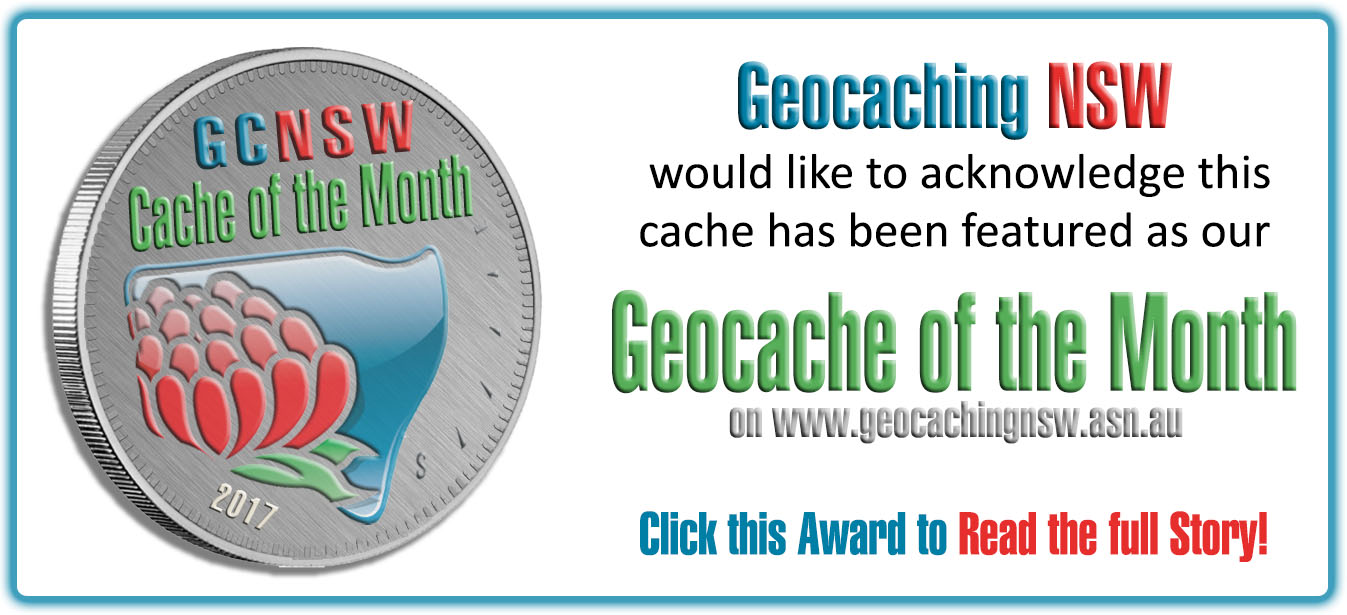The Wool Road Mystery Cache
RiverRuners: A victim of the bush fire.
-
Difficulty:
-

-
Terrain:
-

Size:  (small)
(small)
Please note Use of geocaching.com services is subject to the terms and conditions
in our disclaimer.
The cache is not at the listed co-ordinates. Instructions on how to solve this puzzle are attached below. Check sum =29
The Wool Road was built in 1841 and connected the town of Nerriga to South Huskisson on Jervis Bay. South Huskisson is now known as Vincentia. The route was marked out by Surveyor James Larmer in 1840 and was based on explorations as early as 1831.The road was to take agricultural produce - wool, wheat, hides, etc from the Braidwood, Goulburn and Canberra areas to the coast for shipping to Sydney. The alternative was a route through Bungonia which took 3 weeks.
The road began near Nerriga, forded the Endrick River nearby and found its way up onto the plateau by a ridge of Bulee Mountain. A gap (the Bulee Gap) had to be cut and blasted to allow the route to get through the sandstone escarpment. It then continued eastward to Sassafras, past Tianjara Falls, across to and through the eastern escarpment at the Wandean Gap, down the ridge towards Jerrawangala and then north to Wandandian, past St Georges Basin and so to South Huskisson. Amazingly, the road was completed in about 10 months by a gang of seventy convicts directed by local landowner Colonel John Mackenzie of Nerriga and under the command of Captain John Coghill. Colonel John Mackenzie was a veteran of the Spanish Peninsula War under Wellington. He was one of the early settlers in the Nerriga area, purchasing 900 acres in 1836.
The present road from the coast (Main Road 92) follows the line of the Wool Road from about Boolijah Trig to Nerriga. However, the modern route at the Bulee Gap differs slightly from the original which allows one to trace an actual section of the old road. The Bulee Gap cut by the convicts (the marks of their drills can be seen here) can readily be inspected and then the section leading downhill to join the modern road again. In some parts of this section, on the downhill side, the road has stone embankments. These embankments are only three or four rows high and there is no evidence that the rocks were cut to shape. At the moment this is not an easy walk; there is a missing section immediately after passing through the gap and many trees lie across the road - a consequence of the bushfires in January 2003. Something should be done to preserve this section of road; the only portion of the Wool Road in anything like its original condition. The missing section is the result of an intentional detonation - a wartime (WWII) decision based on invasion fears.
If you visit Wandean Gap and look carefully you will see a few traces of the drill holes which were made to break up the sandstone. Taking a 2-wheel drive vehicle through the gap is not recommended - the road surface is very rough.
In 1842 the road from Nerriga to Braidwood was upgraded using convict labour funded by Colonel Mackenzie and Dr Thomas Braidwood Wilson. Braidwood Wilson (1792-1843) is an interesting person. Born in Scotland, he was Surgeon Superintendent of Convicts transported to Australia by the Royal Navy. The town of Braidwood is named after him. He was one of the early settlers in the area and became a magistrate of the district. For a short time in his life he had been an explorer in the south west of West Australia. He was interested in botany and has a grevillea named after him - grevillea wilsonii. Also, he is reputed to have introduced bees (European honeybees) to Tasmania.
The Sydney merchants were not in favour of the development of a port on Jervis Bay. They wanted to ensure their trade monopoly. Their will prevailed, the port of South Huskisson did not prosper, and that part of the Wool Road between Boolijah Trig and the road now known as the Princes Highway fell into disrepair. Other reasons for the demise of this part of the Wool Road were the development of Nowra (initially sited at Terara) and and the present roads (Turpentine-Tomerong and Turpentine-Nowra). Nerriga's link with the coast was used by bullock teams and coaches, by drovers with cattle and sheep, and throughout the second half of the 19th century by miners heading to the gold fields beyond Nerriga.

Additional Hints
(Decrypt)
Pna'g xavg ? Nfx lbhe Zhz be Tena sbe uryc ;)